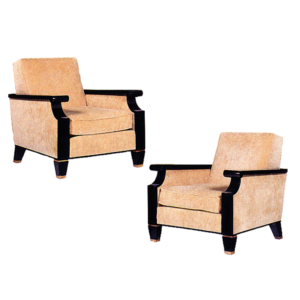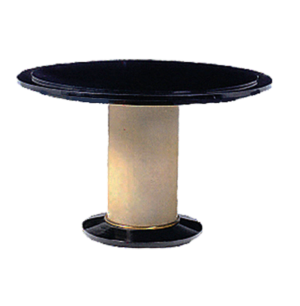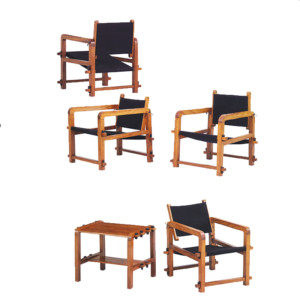(1900-1984)
Literature: Art Deco Furniture. Alastair Duncan; ART DECO, by Victor Arwas
Jacques Adnet was among the most important French designers, architects, and interior designers who worked during the Art Deco period, and beyond. He is best known and respected for his modern and often original designs that relied on simple and elegant forms, and eschewed excessive ornamentation, in a sense, rejecting the trend towards luxurious materials such as ivory and Mother-of Pearl inlays, gilded bronze, and various inlays of rare woods that typify much of the finer Art Deco furniture.
Adnet was born in Chatillion-Coligny, near Bourgogne, on April 20, 1900. Jacques originally attended the Municipal School of Design, in Auxerre, with his twin brother, Jean, but transferred to the Ecole des Arts Décoratifs in 1916. While at the Ecole des Arts Décoratifs, Adnet studied architecture under Charles Genuys.
Following his graduation from the Ecole des Arts Décoratifs, Adnet worked for a while for Tony Selmercheim, learning and perfecting his cabinetry skills. Following World War One, the brothers Jacques and Jean worked for La Maîtrise – the important decorative arts department of the famed Printemps department store,
From 1923 to 1928, Jacques and Jean worked together, and displayed many of their designs at the important Salons. During this time, they shared credit under the name J.-J. Adnet. One of the most notable works that Jacques created during this time was the salle commune of the Ile-de-France, which he designed in 1926.
In 1925, Jacques and Jean exhibited their Art Deco furniture at the Exposition Internationale des Arts Décoratifs et Industriels Modernes – the famed exhibition from which the term Art Deco emerged. The brothers exhibited work in the Ambassade Française, La Maîtrise, and also at their own stand. Located on the Esplanade des Invalides, Jacques and Jean’s stand was decorated with a variety of tubular glass light fixtures, bordered with frosted tubes that had been arranged in zigzags and right angles. This effect brought the exhibition to life by highlighting the sparkle of the metal in their designs. Jacques and Jean gained a great deal of recognition and praise for both the work they displayed at the Exposition, as well as the design of their stand.
Jean remained at La Maîtrise, and eventually became a sales manager for Galeries Lafayette. Meanwhile, by 1928, Jacques had moved on from La Maîtrise, and became the director of La Compagnie des Arts Français, a firm that had earlier been established by Louis Süe and André Mare in 1919, but, sadly, had failed to prosper. The original purpose of La Compagnie des Arts Français was to promote ‘Evolution dans la Tradition’ – using traditional furniture forms, but in a modern way. When Jacques became the director, however, he completely revolutionized its style. Jacques rejected the past, and used La Compagnie des Arts Français as a show case to display his modernistic, avant garde designs.
Jacques’ style can be described as pared-down and simplified. His goal was to create furniture with a rigidly functional aesthetic – extremely sleek, and devoid of ornamentation whenever possible. Adnet was one of the first artists to insist on incorporating metal and glass into the structure and decoration of his furniture. He believed that these materials, when incorporated into his furniture, complimented the spaces they filled, and they worked well with the relatively new invention – electricity. Among his most important designs were those for lighting. While his decorative element was smoked glass, Jacques utilized many other materials, including exotic woods, such as peroba and bubenga, chromed metal, leather, galuchat, and parchment.
By the late twenties, Jacques had established himself as a genius designer. He was exhibiting various interiors, marketed by Saddier et ses Fils, at both Salons. Many decorators were implementing his machinisme style, and his strong reputation brought about many prominent commissions throughout the 1930s. Adnet collaborated with many important designers, including Edouard Scheneck (nickel and glass), Louis Gigou (furniture mounts), Jean Besnard (ceramics), Mme Léoné Huet (carpets and fabrics), and René Coulon, with whom he worked on the Saint-Gobain pavilion for the 1937 Exposition.
Adnet continued to concentrate on a variety of projects until the end of his life. In 1948, he became the President of the Salon des Artistes Decorateurs, and remained its president for one year. During this time, Adnet worked on many decorating projects, including the study of the French President at the chateau de Rambouillet, Frank Jay Gould’s house, Mme. Alice Cocea’s apartment, the private apartments of President Vincent Auriol at the Elysee, as well as many luxury ocean liners, including the Ferdinand de Lesseps, and Unesco.
Beginning in the late 1940’s, Adnet worked with the renowned firm of Hermés, designing very chic leather-covered furniture, developing a signature style, which continued through the 1950’s.
When the La Compagnie des Arts Français closed in 1959, Adnet left his position as director, and accepted a position as the director of the Ecole Nationale Supérieure d’Art Décoratif.
Jacques Adnet died in 1984, leaving behind a strong reputation for having transformed the standards of architecture and design.
Showing all 3 results




